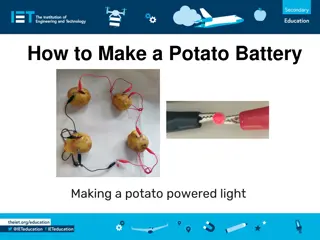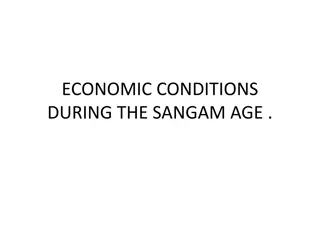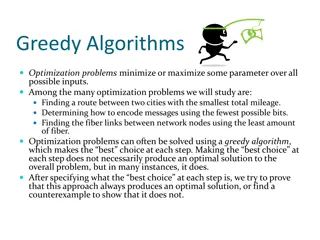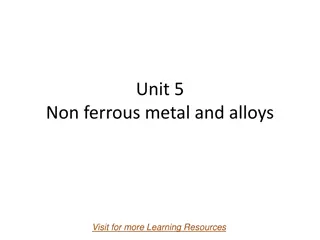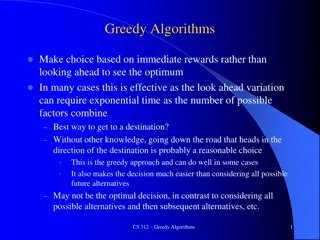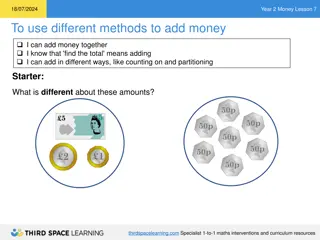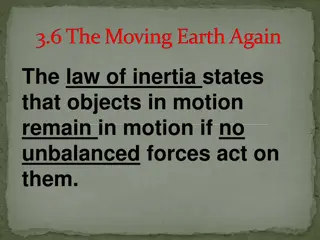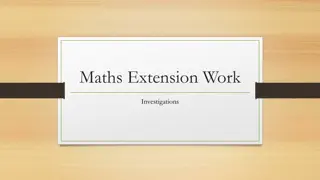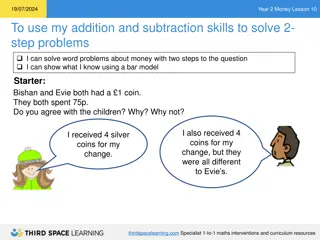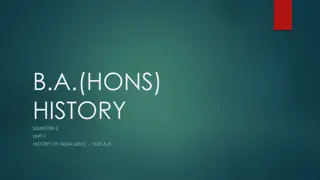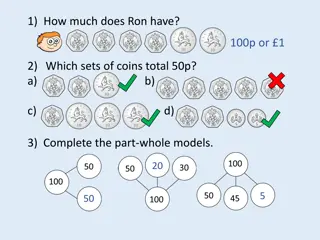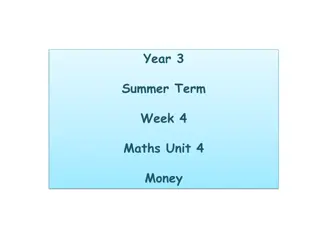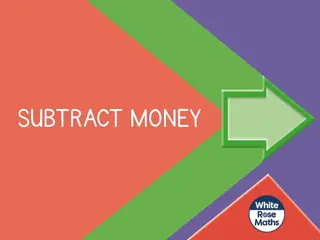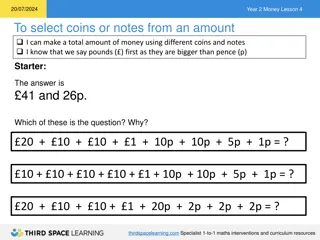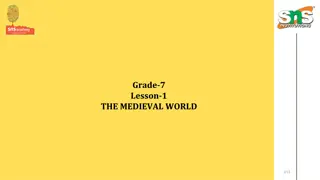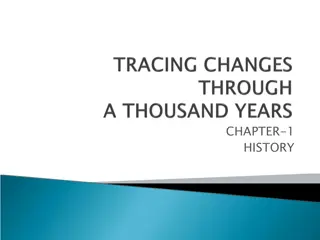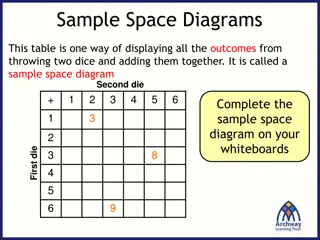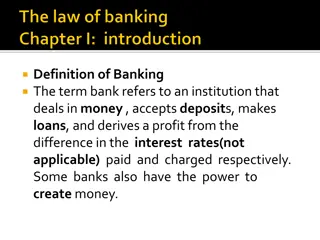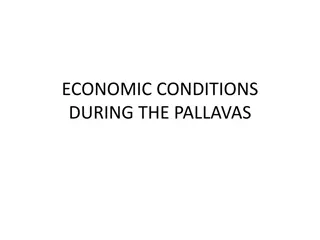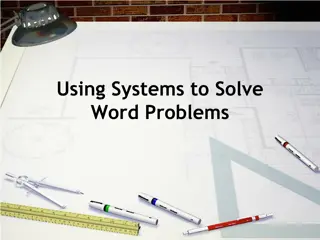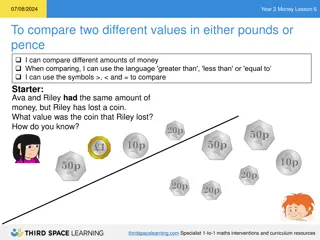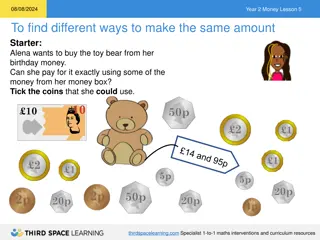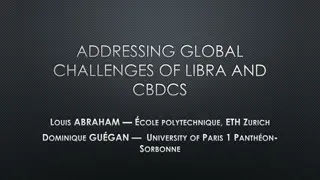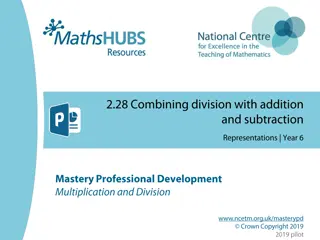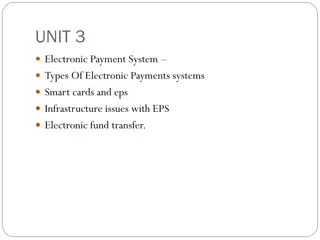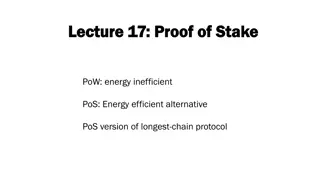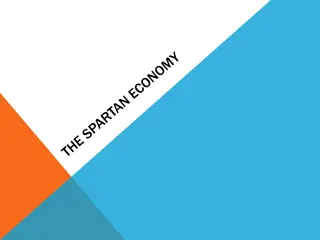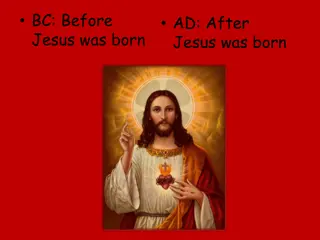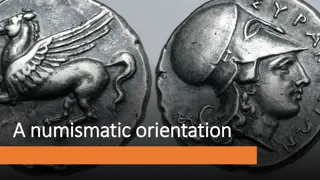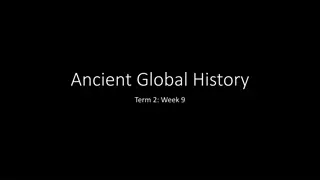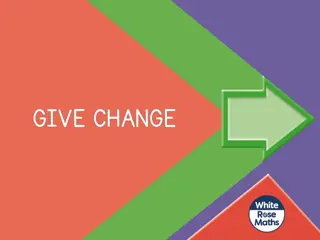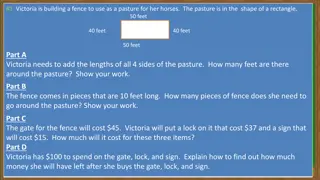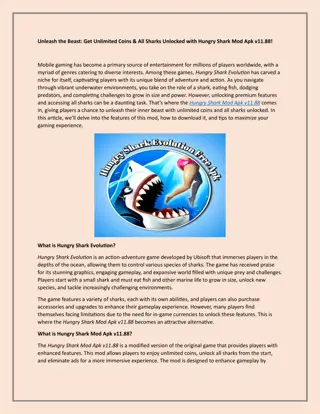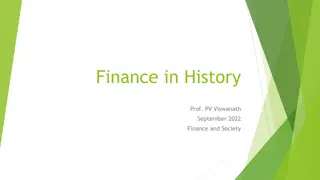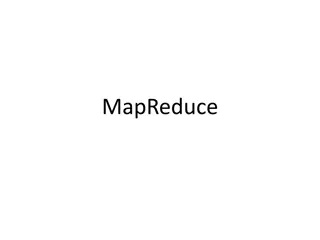Coins of Early and Classical Athens
Explore the evolution of Athenian coinage from early to classical times, reflecting civic values and community identity through silver currency. Discover the rich history and significance of these ancient coins.
1 views • 29 slides
Introduction to Probability Concepts in CSE 312 Spring 24 Lecture 5
Today's lecture in CSE 312 Spring 24 covers the basics of probability, including sample spaces, events, and probability calculations. Understand the foundational processes behind quantifying uncertainty, such as flipping coins, rolling dice, and shuffling cards. Dive into concepts like sample spaces
2 views • 26 slides
How to Make a Potato Battery for Lighting an LED Bulb
Learn how to create a potato battery to power an LED bulb with simple materials like potatoes, coins, nails, crocodile clips, and an LED. Follow the step-by-step instructions provided along with safety guidelines to safely conduct this science experiment.
8 views • 13 slides
Fake Currencies For Sale - undetectablecounterfeitbills.com
Fake Currencies for sale are counterfeit bills or coins that are illegally produced and circulated as genuine currency. These fraudulent replicas are often made with the intention of deceiving individuals and businesses into accepting them as legitimate forms of payment.\nText\/ WhatsApp: 1 (507) 5
3 views • 3 slides
Economic Conditions During the Sangam Age
Agriculture was the primary occupation, with paddy and rice as main crops. Weaving, spinning, fishing, and hunting were vital industries. Trade thrived through barter initially and later coins. Local markets like Angadis and port cities like Puhar facilitated trade. Roman gold coins indicate extensi
3 views • 6 slides
Greedy Algorithms in Optimization Problems
Greedy algorithms are efficient approaches for solving optimization problems by making the best choice at each step. This method is applied in various scenarios such as finding optimal routes, encoding messages, and minimizing resource usage. One example is the Greedy Change-Making Algorithm for mak
0 views • 12 slides
Properties and Applications of Copper Alloys
Copper and copper alloys are essential materials due to their excellent properties like ductility, malleability, high conductivity, and corrosion resistance. Various types of copper alloys such as brasses are widely used in electrical conductors, utensils, coins, and industrial applications. Underst
0 views • 28 slides
Understanding Greedy Algorithms in Computer Science
Greedy Algorithms make decisions based on immediate rewards, prioritizing current benefits over future optimal solutions. This approach is efficient for certain problems, such as finding the best move in chess or solving the coins problem. Greedy algorithms offer simplicity and speed by selecting th
2 views • 69 slides
Understanding Money: Year 2 Lesson 7 on Adding Money Methods
Year 2 Money Lesson 7 focuses on using different methods to add money, such as counting on and partitioning. Students learn to find the total by combining amounts in various ways, including mixing notes and coins, differentiating values, and working with pounds and pence. The lesson includes activit
1 views • 26 slides
Understanding Inertia and Motion in the Moving Earth
Inertia and motion in a moving Earth debunk the argument against Earth's movement using examples of birds catching worms on trees and flipping coins in moving vehicles. Objects on Earth move with Earth's motion, showcasing the principle of inertia in action.
2 views • 7 slides
Fun Mathematics Investigations for Kids
Engage your child in stimulating mathematical investigations with scenarios like choosing snacks, dividing coins into bags, and solving puzzles in a sweet shop. Encourage independent thinking and problem-solving skills while exploring concepts like combinations, ordering costs, and making decisions
1 views • 10 slides
Developing Money Problem-Solving Skills in Year 2 Lessons
In this educational material, Year 2 students enhance their addition and subtraction skills through solving two-step money-related word problems. The content includes scenarios involving coins, expenditures, and calculations to determine new totals. Through bar models and interactive exercises, lear
0 views • 26 slides
Sources of Information in Delhi Sultanate Period
The sources of information in the Delhi Sultanate period include inscriptions found on coins, monuments, and tombstones. Historical writings in Persian language provide valuable insights into the administration and history of the Sultanate. Epigraphs and numismatics also play crucial roles in unders
0 views • 8 slides
Learning About Coins and Their Values
Explore exercises involving different coin combinations to understand values in pence, convert amounts, and identify missing coins. Get familiar with converting pounds to pence and vice versa through fun examples like Rosie's coin collections.
0 views • 10 slides
Year 3 Maths Unit on Money: Combining Coins and Adding Amounts
This Year 3 Maths unit focuses on money, teaching students how to use combinations of coins to make amounts beyond 1, add amounts in pence, and add amounts in pounds and pence. The curriculum includes practical activities and challenges for students to explore and deepen their understanding of money
0 views • 23 slides
Solving Math Problems with Ron and Coins
Ron has a set of coins and spends a specific amount in each scenario, requiring calculations for remaining amounts, subtractions, and completing additions to reach specific total amounts. Various models and number lines are used to illustrate the problem-solving process.
0 views • 15 slides
Money Lesson 4: Selecting Coins and Notes
Explore engaging money lessons for Year 2 students with exercises on selecting coins and notes to make specific amounts. Follow Lola, Jenson, and Bella as they use different denominations to fulfill their shopping needs, teaching valuable math skills in a fun way.
0 views • 26 slides
Unveiling the Medieval World: Discoveries and Chronicles
Delve into the Medieval World through archaeological findings like broken pottery, coins, and shells, shedding light on the inhabitants of a region. Explore the divisions of the Medieval Period, names of India, major historical developments, and sources like temples, coins, and literary works. Chron
0 views • 13 slides
Exploring the Historical Developments from 700 to 1750
The study of history between 700 and 1750 presents a vast array of challenges due to the diverse technological advancements, cultural shifts, and societal changes that occurred during this period. Historians rely on a variety of sources, such as coins, inscriptions, and manuscripts, to understand th
0 views • 11 slides
Exploring Sample Space Diagrams for Probability Analysis
Understand sample space diagrams through visual representations of dice games and coin toss scenarios to determine probabilities of different outcomes. Explore fair game scenarios and practice calculating probabilities based on various game rules involving dice and coins.
0 views • 8 slides
Economic Development During Pandya Period
Agriculture, industry, trade, and commerce played crucial roles in the economic growth of the Pandya period. The state focused on improving irrigation facilities, leading to flourishing trade and commerce. Agriculture was the primary occupation, with lands divided into different categories. Industri
0 views • 10 slides
Evolution and History of Banking: A Comprehensive Overview
Banking has ancient origins, dating back to Babylon in 1800 BC. Over time, banks evolved from dealing in coins to accepting deposits and making loans. The collapse of the Roman Empire saw a decline in banking, only to be revived in Italian towns like Florence and Genoa. English bankers in the 17th c
0 views • 24 slides
Economic Conditions During the Pallavas
The economy of the Pallava Kingdom was primarily based on villages and agriculture, with crops like paddy and cotton extensively cultivated. The period saw the development of Brahmadeya villages, increased village numbers, and the emergence of important trade centers like Kanchipuram. Internal and f
1 views • 17 slides
Solving Word Problems Using Systems of Equations
Learn how to solve practical problems by setting up and solving systems of equations. Follow the steps of defining variables, writing equations, solving, and answering the questions with examples covering various scenarios such as buying bouquets, calculating ticket prices, distributing coins, and d
6 views • 15 slides
Money Lesson: Comparing Values in Pounds and Pence
Year 2 students learn to compare different values in pounds and pence using language like 'greater than,' 'less than,' or 'equal to,' along with symbols such as >, <, and =. Through engaging activities, they practice comparing amounts of money and identifying the value of lost coins. Visual aids sup
0 views • 26 slides
Exploring Different Ways to Make the Same Amount with Coins and Notes
Engage in a Year 2 Money Lesson focusing on finding various ways to create identical amounts using a mix of coins and notes. Help Alena figure out how to purchase a toy bear from her birthday money, challenge students to identify different combinations of coins that make the same total, and assist D
2 views • 26 slides
Understanding the Global Impact of Libra and CBDCs
Explore the evolution of Libra, challenges & risks associated with CBDCs, stable coins, and the technological impact of cryptocurrencies. Louis Abraham & Dominique Gu.gan shed light on the regulatory context, technical considerations, and the intriguing aspects of these financial innovations.
0 views • 24 slides
Math Problem Solving Scenarios for Students
Practice solving math problems involving coins, paints, cereals, bananas, water, and sweets with various scenarios. Explore different methods to find solutions and enhance mathematical reasoning skills.
1 views • 14 slides
Evolution of Electronic Payment Systems: From Barter to Cryptocurrencies
The evolution of payment systems has come a long way, from the barter system in ancient times to the modern era of cryptocurrencies and digital payments. This journey includes the invention of coins, paper money, banknotes, cheques, credit cards, and the latest digital payment methods. The impact of
0 views • 24 slides
Mathematical Problem-solving Challenges for Week 21
Engage in various mathematical challenges involving coin counting, ticket sales, algebraic expressions, and more. Solve problems on identifying the number of coins, selling baked goods, determining vegetable costs, and finding slope-intercept forms. Sharpen your math skills and enhance problem-solvi
1 views • 15 slides
Proof of Stake: Energy-Efficient Alternative to Proof of Work
Proof of Stake (PoS) is presented as an energy-efficient replacement for Proof of Work (PoW) in blockchain protocols. PoS allows meaningful participation based on stakeholders' coin ownership, proportional to their stake. The process of finding nonces in PoW is replaced by owning coins in PoS to par
0 views • 16 slides
Spartan Economy Overview and Myths
Spartan economy was controlled by the state with property ownership restrictions. They used iron currency bars to deter trade, but in reality, valued goods in silver coins. The land was redistributed to address inequality. Some myths like the iron bars and vinegar treatment were considered absurd.
0 views • 14 slides
Exploring Roman Civilization: Contributions and Daily Life
Delve into the intriguing world of ancient Rome through a visual journey showcasing the impact of Roman civilization. Discover the architecture, art, infrastructure like roads and drains, calendar systems, coins, and the luxurious baths they enjoyed. Uncover the influence of the Roman Empire on vari
0 views • 20 slides
Understanding Numismatics: Exploring the World of Ancient Coins
Delve into the realm of numismatics with a focus on ancient coins, from describing coin features to deciphering mint details and weight standards. Uncover the roles of money in society and gain insights into the terminology, abbreviations, and denominations of ancient coinage.
0 views • 13 slides
Ancient Global History - Textiles, Burials, and Coins in Ancient Palmyra and Tillya Tepe
Explore the fascinating details of ancient silk textiles found in Palmyra, the intriguing burials at Tillya Tepe in Afghanistan, and the historical significance of coins in Central Asia - shedding light on the interconnectedness of cultures in ancient times.
0 views • 14 slides
Math Challenges Involving Coins and Change
Explore various math problems involving coins, change, and purchases. Solve scenarios where individuals buy items, receive change, and calculate remaining amounts. Practice addition and subtraction with coin values to improve mathematical skills and understanding.
0 views • 13 slides
Mathematics Problem Solving Tasks
Victoria is building a rectangular fence for her horses, Raul is counting his coins, Peta is solving expressions, James is managing his wallet money, Jackie is dealing with pennies, and Hanna is working with different types of coins. The tasks involve calculating fence perimeter, counting coins, sol
0 views • 38 slides
Unleash the Beast: Get Unlimited Coins & All Sharks Unlocked with Hungry Shark
\/\/hungrysharkworldapk.com\/\nThe Hungry Shark Mod Apk v11.88 provides an exhilarating way to experience Hungry Shark Evolution without the limitations of the standard version. With premium features unlocked, unlimited coins, and all sharks availabl
0 views • 5 slides
Evolution of Money: From Barter to Coins in Ancient Civilizations
In ancient Mesopotamia and China, various commodities like barley, metals, and cowries were used as currencies before the emergence of standardized coinage. Control over the money supply became essential for political authority, leading to the minting of coins. The surplus production in societies al
0 views • 10 slides
Understanding MapReduce: A Real-World Analogy
MapReduce is a programming model used to process and generate large data sets with parallel and distributed algorithms. In this analogy, the process of depositing, categorizing, and counting coins using a machine illustrates how MapReduce works, where mappers categorize coins and reducers count them
0 views • 43 slides


